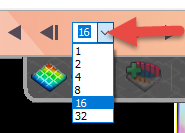
GeoTeric’s Adaptive Fault Interpretation is a powerful data driven and interpreter guided method of structural interpretation. Since the Graph Theory algorithm is used by the Adaptive Interpretation System to generate data following results, not many fault sticks are required to generate an accurate fault plane in GeoTeric. This allows for an efficient method of interpretation.
The Adaptive Faults in GeoTeric can be exported as ASCII sticks or TSurf surfaces. However, some users may want to have many fault sticks spaced at regular intervals so that they can be used more effectively for modelling in packages that do not accept TSurf format surfaces.
This can be easily done in GeoTeric by simply using the slice player and the accept line button, which will convert intersections of the data following surface into sticks each time the slice plays through the fault plane.
Step 1: Activate the Fault Set.

Step 2: Bring a slice to one end of the fault.
Step 3: Set the slice player interval to fault stick spacing desired.

Step 4: Accept the line by holding down the ‘A’ key and press play in the desired direction, making sure that the ‘A’ key is held down.

This will result in a fault interpretation that is more evenly spaced, which can then be exported as Charisma ASCII fault sticks. The user can also delete the older fault sticks if necessary.
The video below highlights this workflow and demonstrates how both a vertical slice or a z-slice can be used.
To learn more about how to use the Adaptive Faults, click here.
